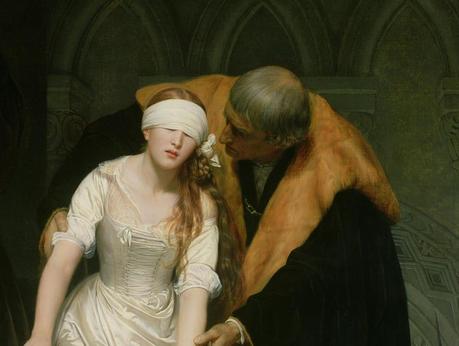
The Execution of Lady Jane Grey, Delaroche, 1833. Photo: National Gallery, London.
The National Gallery in London is a treasure house of beautiful and astonishing works of art, but if you poll a group of people about which one is their absolute favourite, the chances are that Delaroche’s starkly dramatic and somewhat uncomfortably sexy The Execution of Lady Jane Grey will come out as one of the most popular.
Depicting as it does, the execution of a young girl, you’d be forgiven for thinking that this is a somewhat morbid choice but the power and oddly romantic resonance of the piece cannot be denied as the eye feasts on the shimmering white silk of Lady Jane’s gown, the rippling fall of her dishevelled auburn hair, the rich costumes of the ladies slumped and weeping behind her and the austere stone Norman decoration that looms behind her. It’s a huge and astonishing piece that manages in masterly style to wring every iota of tragedy and drama out of the scene that it depicts.
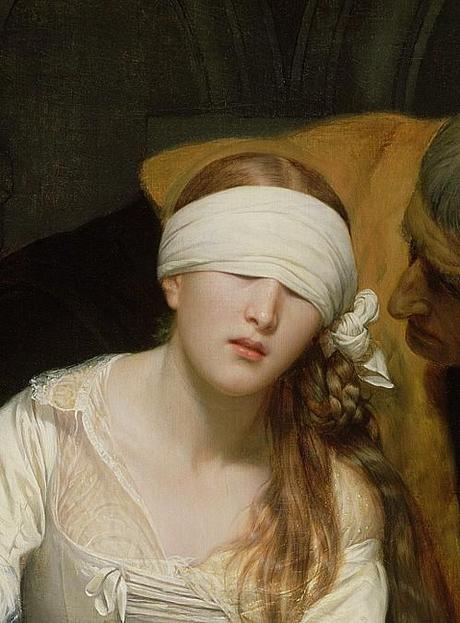
The Execution of Lady Jane Grey, Delaroche, 1833. Photo: National Gallery, London.
I’ve been lucky enough to see this painting for myself hundreds of times over the years and even attended the 2010 exhibition devoted to it, where it was displayed alongside Delaroche’s preparatory sketches and other masterpieces of the same history painting genre such as King Edward V and the Duke of York in the Tower of London, also by Delaroche and my favorite Anne Boleyn in the Tower of London by Cibot.

Anne Boleyn in the Tower of London, Cibot, 1835. Photo: Musée Rolin.
What I found particularly interesting is the link between Delaroche’s melodramatic depiction of Lady Jane Grey’s final moments as, blindfolded and ready for the final blow, she misjudges the distance that she must walk to the block and stumbles blindly forward unable to find it with her hands, and his fascination with the events of Revolutionary France. Delaroche began working on his masterpiece in 1833 when the events of the July Revolution of 1830 which finally deposed the Bourbons once and for all were still fresh in the memory.
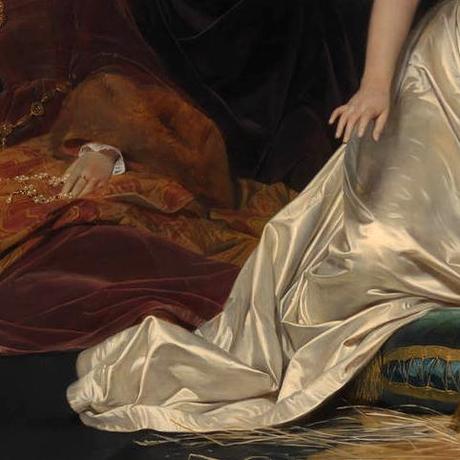
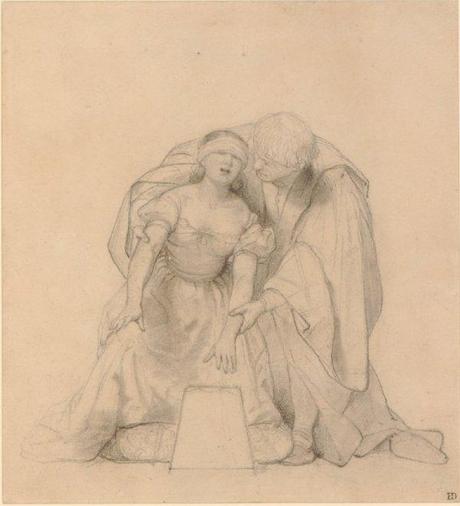
The Execution of Lady Jane Grey, Delaroche, 1833. Photo: National Gallery, London.
It was the fate of the earlier Bourbons during the Terror that really inspired Delaroche though and his preparatory sketches reveal his twin preoccupations with the French Revolution and English history, with his interest in one giving rise to his dramatic evocations of the other. Alongside his drawings of Lady Jane Grey’s execution, there were sketches of the Dauphin and Madame Royale in the Temple prison, clutching each other in the same way as the Princes in the Tower, while presumably an unseen menace lingered beyond the cell door. It’s clear also that The Execution of Lady Jane Grey was inspired as much by the fate of Marie Antoinette, whom he saw as a tragic and persecuted heroine of persecution as by the demise of Lady Jane. However, with anti-Bourbon feelings still riding high in the post 1830 world, it was safer by far to explore the theme of martyred Queens via the medium of a sixteenth century tragedy than one that was rather closer to home.
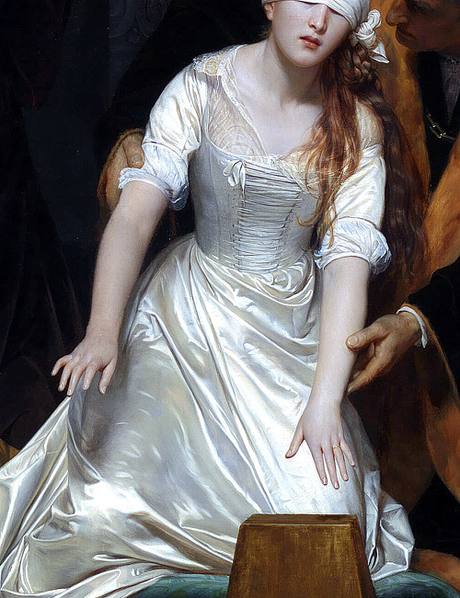
The Execution of Lady Jane Grey, Delaroche, 1833. Photo: National Gallery, London.
The resulting work is a jewel like masterpiece, a paen to martyred Queens and a tribute to the masterly power of the painter’s brush to wring every possible emotion out of the viewer. Taking a great deal of artistic license with the known facts, Delaroche sets the scene carefully by creating a backdrop to the drama that is both austere and decorative, creating a dank setting for the vibrant color and texture at the foreground – one gets the uneasy feeling that his pallid, virginal Lady Jane has never been nearly quite so alive, so vibrant or so sensual as at the moment of her death. Her youthful beauty is luminous and radiant as she prepares for death and the eye, unable to resist the richness before it, wanders and lingers on the shimmering white silk of her gown, the berefit expressions of her ladies in waiting, the rich brocade and jewels on her discarded dress that one of them clutches on her lap and the serious and intense way that the gazes of both of the men, the Lieutenant of the Tower and the executioner are turned upon her. There can be no doubt at all that we are in the presence of martyrdom – the scene is wholly secular, but nonetheless the painting owes as much to depictions of religious martyrdom as it does to the dark drama of history.
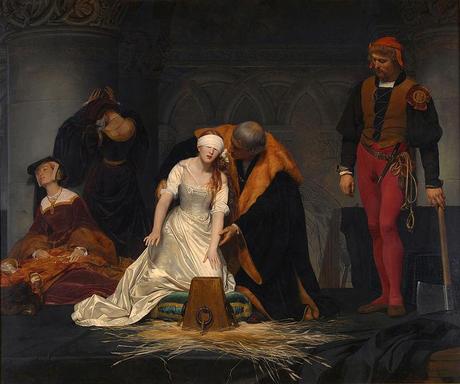
The Execution of Lady Jane Grey, Delaroche, 1833. Photo: National Gallery, London.
Even though, academically, one knows that the execution of Lady Jane Grey took place outside and was an altogether rather more decorous affair (stumbling around to find the block aside), all of that is forgotten as one gazes in rapture before the scene. Forgotten too is the character of the real Lady Jane, who was not really the mawkishly innocent little sacrificial lamb of fond Victorian imagining but rather a diminutive and not altogether very pleasant, religious bigot with a sharp tongue and rather entitled manner, fond of lecturing her elders about their religious failings and somewhat more keen to wear the crown than posterity would have us believe. She did not deserve to die but at the same time was not quite the pretty, tragic ingenue of Delaroche’s almost fevered imagining, her red hair falling loose about her in becoming disarray, rosy lips parted and throat bared as if she is about to lose her virginity rather than receive the death blow from the wickedly sharp axe that is turned out so very slightly towards the aghast viewer, who realises too late that they along with everyone else looking at the picture has been cast in the role of spectator to the actual execution.

The Execution of Lady Jane Grey, Delaroche, 1833. Photo: National Gallery, London.
Intriguingly, it seems that the National Gallery once did an experiment to track the gaze of people looking at The Execution of Lady Jane Grey and found that the eye was drawn immediately to the stark white clad figure of Lady Jane in the center before moving down her arm to the block, perhaps noting the slender wedding ring on her finger, and then across to the axe and up to the face of the executioner as he looks down at Lady Jane. They then skimmed across the ladies in the background, perhaps noting that the rich pile of clothes in the lap of one of them are Lady Jane’s discarded rich garments before returning once again to Lady Jane. It was also noted that they all paid close attention to the red leggings worn by the executioner and, more particularly, their contents as emphasised by the carefully placed dagger, underlining once again the uncomfortable sensuality of the piece and positioning of Lady Jane as beautiful young martyr about to be despoiled in more ways than one by the executioner’s axe.
